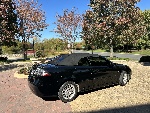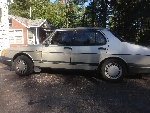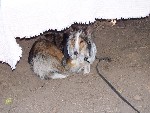 |
 |

1985-1998 [Subscribe to Daily Digest] |
| [Main 9000 Bulletin Board | BBFAQ |
Prev by Date | Next by Date | Post Followup ]
Member Login / Signup - Members see fewer ads. - Latest Member Gallery Photos
Strut replacement writeup (very long) Posted by sam96CS [Email] |
I wrote the notes below as I replaced my oem struts with Bilstein HD struts. Pictures are in a picture gallery at my saabnet profile page. The biggest hassle I had was removing stuck bolts at step 4, but not everyone has this problem. Another major hassle was finding a suitable socket for tightening a new 22 mm nylon locknut at the top of the piston rod.
0. The tools you need to disassemble are NOT necessarily the same tools you need to assemble. Make sure you have all the tools before you begin. You may also want to buy some bolts, locknuts and washers for this job (I provide specifications later). The tools and supplies I used included floor jack, jackstands, wheel chocks, 13/16" spark plug socket, 7 mm Allen wrench, vice grips, 3/4" box wrench, 18 mm box wrench, ratchet wrench with 3/8" drive, sockets sized 16, 17, 18 and 19 mm, 18" breaker bar, 25" breaker bar, torque wrench, PB Blaster, carpenter's hammer, engineer's hammer, standard screwdriver, trouble light, camera, safety glasses, gloves, rags, Fantastik cleaner, and a 22 mm strut socket that I had to modify with a bench grinder. I would have had major problems without access to my spouse's car while this job was underway. The Haynes manual rates this job as difficult, suitable for experienced DIY mechanics. The job is frustrating, can take longer than you expect, and is an excellent candidate for paying someone else to do for you. If you don't have trouble at Step 4, then you're lucky. The rest of the job is relatively easy.
1. Loosen the top strut nut (piston rod nut) a half turn. The best tool for this is a 13/16" spark plug socket which has a hex nut at the top. You can turn this socket with a wrench and insert a 7 mm Allen wrench down the middle of the socket to prevent the piston rod from turning. Hold the 7 mm Allen wrench still with vice grips while turning the 13/16" spark plug socket with a 3/4" wrench. Loosen the nut only a 1/2 turn! Do this for both the driver and passenger sides. If the nut won't budge, then remove the Allen wrench, spray on some PB Blaster and turn the nut slightly using a 25" breaker bar. After that the nut can be turned while the Allen wrench is held still.
2. Loosen the 19 mm wheel bolts on both front wheels, put chocks behind rear tires, jack up the front end of the car, secure on jack stands, and remove a front wheel.
3. Disconnect the brake line from the strut body clip. This takes a firm upward pull with both hands on the brake line close to the strut body clip. Disconnect the ABS sensor wire (if applicable) from the sensor cable bracket. Be gentle with the ABS sensor wire because its protective outer jacket gets brittle with age.
4. The strut assembly is held by 5 bolts, 3 upper and two lower. The lower 17 mm bolts thread into 18 mm flanged nylon locknuts. Loosen and remove both bolts. If your 9K has ABS brakes, then set aside the bracket that holds the ABS cable. You will re-install the ABS bracket later. Now re-insert one of the 17 mm bolts to support the strut body temporarily as you remove the 3 upper bolts. If you have trouble with a stuck bolt then read the Stuck Bolt Removal paragraph below.
5. Remove the 3 upper 16 mm bolts. On the passenger side one of these bolts is located close to an A/C line and an ABS sensor cable. Be careful to avoid damaging them. With the 3 upper bolts removed the only thing holding the strut assembly is the lower bolt that you left inserted in the step above. Remove this bolt and remove the strut assembly. It is easier to slip the strut assembly out on the ABS cable's side of the hub. Lower the strut until the top of the strut clear the top of the wheelwell, then lift out.
6. Lay the strut on a surface that will not damage the paint on the spring as you compress it. Compress the spring until it is no longer pressing against the spring seats. You can see and feel the looseness when it is compressed enough. Oil the threads on the compressors before applying a lot of torque. The compressors should be placed on opposite sides of the spring and tightened in steps. I alternated between turning one side 6 quarter turns, then the opposite side 6 quarter turns to keep the compression balanced. One compressor spanned 5 coils. The other compressor spanned 4. The compressor nut turned with a 3/4" crescent wrench and takes a fair amount of effort near the end. This step is neither dangerous nor difficult if you buy or rent a good pair of compressors. Avoid the cheap ones.
7. Step 6 above is mandatory before this step! Remove the piston rod nut at the top of the strut. This is the same nut that was loosened one half turn at step 1. Remove it by the same method, holding the piston rod still with the 7 mm Allen wrench while turning the nut with the 13/16" spark plug socket.
8. Pull off the strut bearing, the upper spring seat and the spring (still compressed). Pull off the compression stop, which is an orange rubber part that is wider at the top than at the bottom. The lower spring seat (it looks like a metal ring) will also pull off. Pull off the rubber boot. The boot fits tight when you slide it up to the bottom of the dust cap. The boot stretches and can be removed by hand. The dust cap is a black plastic part about 2-1/2" in diameter and 1-1/4" high. It can't be transferred to a Bilstein HD strut due to the welds and slightly larger diameter at the top of the Bilstein strut. You may need the dust cap if you replace the original strut with the same brand or a more similar design. The cap can be pushed up from the bottom by pushing and prying against its bottom edge with a large standard screwdriver. Removing the dust cap is the final disassembly step.
9. Clean the parts you have removed that will be re-used. This isn't strictly necessary, and the parts don't need to be squeaky clean. Cleaning helps you discover defects and confirm that the parts you plan to re-use are good to go another 100,000+ miles. The paint will be rubbed off of the spring where it contacts the spring seat. You can paint it now if you are so inclined and aren't in a hurry.
10. The first part to install on the new strut body is the dust cap, if applicable. If it will fit your brand of replacement strut, then it will slip over the top of the painted strut tube. Tap down with a rubber hammer until it is fully seated.
11. For the Bilstein HD the first step is to install the rubber boot. Inspect the boot for tears; the boot keeps dirt out of the strut's moving parts so the strut won't wear out prematurely. At the bottom of the boot is a tab that should be aligned with the center of the strut's lower mounting bracket. The boot can be installed by hand if you're patient and persistent, which is a good idea because you don't want to tear the boot using tools on it. Getting it started is the hard part. I had to use a small screwdriver to get the second boot started. There are protruding welds at the top of the tube. If the bottom of the boot was folded under itself as one of mine was, then it will resist being installed correctly. A little soap and water makes it easy to work it down until the bottom of the boot is close to where the spring support is welded to the tube. Make sure the tab stays aligned with the center of the lower mounting bracket.
12. Install the lower spring seat so that it fits the cup on the strut body. The spring seat just sits there, and the spring will hold it in place.
13. Put the spring on (still compressed) and align the spring with the lower spring seat. Pull the rubber boot through the middle of the spring. The top flange of the rubber boot goes over the top of the spring, and the rubber flange will be squeezed between the spring and the upper spring seat.
14. Install the orange rubber compression stop on the piston rod with the large diameter hole at the bottom and the small diameter hole at the top. The top of the compression stop is about 1-7/8" from the top of the piston rod.
I discovered at this point that Bilstein's nylon locknut that goes at the top of the piston rod isn't a 13/16". It is 22 mm, and a 7/8" socket fits it. The oem nut is a nonstandard size and can't be bought anywhere. A suitable 7/8" spark plug socket is almost impossible to find. I discovered that Sir Tools makes specialty sockets and ordered their model 4491-A socket. This 22 mm socket has a cutaway for the 7 mm Allen wrench, so I can use a torque wrench instead of guessing the amount of torque. Got it at HandsOnTools. The socket is slightly too large to fit through the hole in the strut bearing. So I used a bench grinder on the socket until it would fit. The old oem nut fits the Bilstein HD strut. Reusing the old nut isn't recommended, but I would have reused it if my socket modification wasn't successful. If you reuse the old nut, then use some blue loctite for peace of mind. This nut must not work loose.
15. Place the upper spring seat and then the strut bearing (preferably a new strut bearing) back on the strut. At the top of the rubber boot is a tab which must be aligned with the notch in the upper spring seat. Line up everything, then tighten the nylon locknut. You must hold the piston rod still with the 7 mm Allen wrench while tightening the locknut. Turn the nut until tight. You won't do the final torque until the new strut assembly is mounted on the car. Now loosen the spring compressors a bit at a time, alternating between them. Keep an eye on the spring seats, rubber boot, and the tab on the rubber boot that should be aligned with the notch in the spring seat. Keep loosening until the compressors can be removed.
16. Now you can place the strut back on the car and tighten the 5 mounting bolts to spec, which is 18 ft. pounds for the 3 top bolts and unknown for the bottom two bolts. I guessed 50 ft. pounds for them. I replaced the nylon locknuts, details at 16A below. Torque the strut top nut to 55 foot pounds. There are two basic approaches to doing this step if you don't have a helper:
16.1 Line up the strut bracket holes with the steering knuckle holes, put the bolts in (don't forget the upper bolt passes through the ABS cable bracket), then use the floor jack to lift the control arm about an inch so that the 3 top bolts can reach their holes. Put the 3 top bolts in until just snug. Remove the floor jack. Put new washers and nylon locknuts on the lower bolts. Don't forget to put the ABS cable back into its bracket and to put the brake line back into its bracket. Then torque everything.
16.2 Put the strut roughly into position and raise the control arm an inch or so with the floor jack. Install the upper bolts first. Then remove the floor jack and align the lower bracket holes with the steering knuckle holes and put in the two bolts (don't forget the ABS bracket on the upper bolt). Put new washers and nylon locknuts on the lower bolts. Don't forget to put the ABS cable back into its bracket and to put the brake line back into its bracket. Then torque everything.
For some reason the first approach was easier on the passenger side and the second approach was easier on the driver side. I did the passenger side first.
17. Remove the other front wheel and repeat steps 3-16 for the other side of the car.
18. Install the wheels, jack the front end high enough to remove the jackstands, lower the car to the ground, then torque the wheel bolts to 88 ft. lbs.
4A STUCK BOLT REMOVAL
This is the worst part of the job. If a bolt will turn with difficulty and won't come out easily then it could be rusted or bent or there could a problem with the steering knuckle hole. You are in for a major hassle. Decide whether you want to continue. If your funds aren't severely limited and you don't mind someone else working on your car then take it to a shop. Otherwise keep reading. If one of the bolts came out (probably the lower one), then put it back in the hole to reduce steering knuckle movement. Either screw the nut onto the end of the stuck bolt to protect the bolt threads or buy a new bolt (class 8 size 12mm x 1.75 x 70 mm long with threads on the final 25 mm of its length). In retrospect I wish I had bought new bolts because removing the stuck bolt is easier if you don't try to save it. Lay a rag across the CV boot below the strut because oil or other solvents will be dripping onto the boot. Use WD-40, PB Blaster, oil, etc. to lubricate the bolt especially where it passes through the steering knuckle. Put on safety glasses and gloves. Then smack it hard and repeatedly with a heavy metal hammer. I mean a really heavy hammer. I got nowhere with two bolts (upper bolts on both sides) until I used a 4 pound engineer's hammer. There's not much room to swing, and the job can take hundreds of blows. Rotate the bolt occasionally. You can also try using the jack to put a slight lift on the control arm so that it's weight won't be working against you. A big part of the problem is that there's enough give in all of the parts that much of your energy with the hammer will be wasted. Both hands on the hammer, eyes on the target, now swing hard and smack it squarely. If the bolt moves a little, then squirt in more lubricant and keep swinging. If you use the nut to protect the bolt then the nut will be ruined by the hammer. Remember to wipe off the lubricant that dripped onto the outer CV boot if you didn't protect it with a rag. This method is hard, but it works. If there is a method that uses finesse instead of brute force then I'd like to know about it. Maybe it would have been easier if I had done step 5 before step 4.
16A. REPLACE THE NYLON LOCKNUTS FOR THE LOWER MOUNT BOLTS
I recommend replacing the nuts because a re-used nylon locknut could fail to maintain torque with serious consequences. Buy class 8 size 12mm x 1.75 nylon locknuts and 12 mm flat washers if you don't buy flanged locknuts like the original nuts. Get them at the specialty fastener section of a big box home improvement store or online at sites like BoltDepot.
No Site Registration is Required to Post - Site Membership is optional (Member Features List), but helps to keep the site online
for all Saabers. If the site helps you, please consider helping the site by becoming a member.
 |
 |
 |
 |
 |



